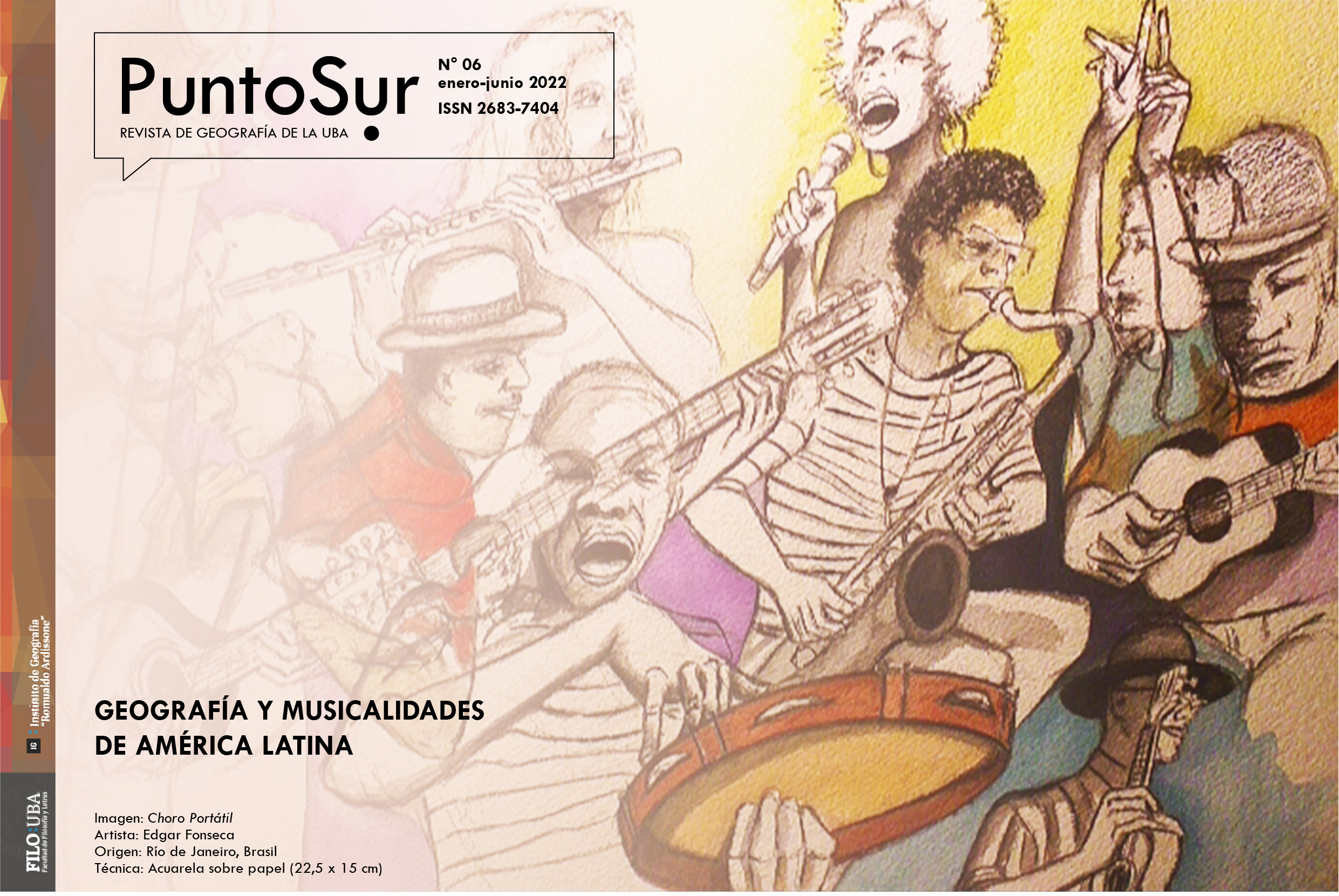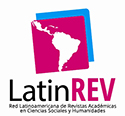Music and tourist heritage spaces. Between action and representation.
Review of Finn, J. (2022). Paisajes musicales del patrimonio y la memoria: investigando la construcción musical de lugar. Revista Punto Sur, 6, XX-XX.
Keywords:
music, landscape, memory, heritage, sonic methods
Abstract
John C. Finn has made a valuable contribution to the geographical study of musical processes in Spanish. In particular, he invites the reader to consider music in a tension between action and representation, and offers a methodological contribution that takes this dynamic into account. In this commentary I reflect on the central arguments of Finn's article to consider its scope and possibilities, as well as eventual limitations that can be complemented from other perspectives.Downloads
References
Adorno, T. y Eisler, H. (2005). Composing for the films. Londres: Continuum. (Publicación original: 1947).
Anderson, B. (2002). A Principle of Hope: Recorded Music, Listening Practices and the Immanence of Utopía. Geografiska Annaler: Series B, Human Geography, 84(3-4), 211-227.
Bennett, J. (2001). The Enchantment of Modern Life: Attachments, Crossings, and Ethics. Princeton: Princeton University Press.
Burgos, R. y Rojas, J. (2013). Son huasteco e identidad regional. Investigaciones geográficas, 80, 86-97.
De Castro, D. (2009). Geografía e música: A dupla face de uma relaçao. Espaço e Cultura, 26, 7-18.
DeNora, T. (2000). Music in Everyday life. Cambridge: Cambridge University Press.
DeNora. T. (2003). After Adorno: Rethinking Music Sociology. Cambridge: Cambridge University Press.
Finn, J. (2011). The Ressonance of Place. Music in Salvador da Bahia. Tempe: Arizona State University.
Finn, J. (2022). Paisajes musicales del patrimonio y la memoria: investigando la construcción musical de lugar. Revista Punto Sur, 6, XX-XX.
Gallagher, M. y Prior, J. (2014). Sonic Geographies: Exploring Phonographic Methods. Progress in Human Geography, 38(2), 267-84.
García Canclini, N. (1990). Culturas Híbridas: Estrategias Para Entrar y Salir de La Modernidad. Grijalbo: Consejo Nacional para la Cultura y las Artes.
Geertz, C. (1988). I-Witnesing: Malinowski’s Children. En Works and Lives: The Anthropologist as Author (pp. 73-101). Stanford: Stanford University Press.
Laurier, E. (2010). Representation and everyday use: how to feel things with words. En B. Anderson y P. Harrison (Eds.), Taking Place: Non-representational theories and geography (pp.131-146.). Londres: Ashgate.
Makagon, D. y Neumann, M. (2009). Recording culture: audio documentary and the ethnographic experience. Los Ángeles: SAGE.
Manassi, L. (2012). Geografía e música: uma introduçao ao tema. Biblio 3W, Revista Bibliográfica de Geografía y Ciencias Sociales, 17.
Prior, J. (2017). Sonic Methods in Geography. Oxford: Oxford Bibliographies.
Schaefer, R.M. (1977). The Soundscape: Our Sonic Environment and the Tuning of the World. Nueva York: Knopf.
Semán, P. (2015). Música, juventud, hegemonía: crítica de una recurrencia. Apuntes de Investigación del CECYP, 25, 119-146.
Tanenbaum, S. (1995). Underground Harmonies: Music and Politics in the Subways of New York. Nueva York: Cornell University Press.
Villamil, J. (2009). La reconstrucción del territorio en la ciudad: un estudio de la música de gaita de la Costa Caribe colombiana en Bogotá. Cuadernos de Geografía, Revista Colombiana de Geografía, 18, 129-142.
Westerkamp, H. (1974). Soundwalking. Sound Heritage, 3(4).
Anderson, B. (2002). A Principle of Hope: Recorded Music, Listening Practices and the Immanence of Utopía. Geografiska Annaler: Series B, Human Geography, 84(3-4), 211-227.
Bennett, J. (2001). The Enchantment of Modern Life: Attachments, Crossings, and Ethics. Princeton: Princeton University Press.
Burgos, R. y Rojas, J. (2013). Son huasteco e identidad regional. Investigaciones geográficas, 80, 86-97.
De Castro, D. (2009). Geografía e música: A dupla face de uma relaçao. Espaço e Cultura, 26, 7-18.
DeNora, T. (2000). Music in Everyday life. Cambridge: Cambridge University Press.
DeNora. T. (2003). After Adorno: Rethinking Music Sociology. Cambridge: Cambridge University Press.
Finn, J. (2011). The Ressonance of Place. Music in Salvador da Bahia. Tempe: Arizona State University.
Finn, J. (2022). Paisajes musicales del patrimonio y la memoria: investigando la construcción musical de lugar. Revista Punto Sur, 6, XX-XX.
Gallagher, M. y Prior, J. (2014). Sonic Geographies: Exploring Phonographic Methods. Progress in Human Geography, 38(2), 267-84.
García Canclini, N. (1990). Culturas Híbridas: Estrategias Para Entrar y Salir de La Modernidad. Grijalbo: Consejo Nacional para la Cultura y las Artes.
Geertz, C. (1988). I-Witnesing: Malinowski’s Children. En Works and Lives: The Anthropologist as Author (pp. 73-101). Stanford: Stanford University Press.
Laurier, E. (2010). Representation and everyday use: how to feel things with words. En B. Anderson y P. Harrison (Eds.), Taking Place: Non-representational theories and geography (pp.131-146.). Londres: Ashgate.
Makagon, D. y Neumann, M. (2009). Recording culture: audio documentary and the ethnographic experience. Los Ángeles: SAGE.
Manassi, L. (2012). Geografía e música: uma introduçao ao tema. Biblio 3W, Revista Bibliográfica de Geografía y Ciencias Sociales, 17.
Prior, J. (2017). Sonic Methods in Geography. Oxford: Oxford Bibliographies.
Schaefer, R.M. (1977). The Soundscape: Our Sonic Environment and the Tuning of the World. Nueva York: Knopf.
Semán, P. (2015). Música, juventud, hegemonía: crítica de una recurrencia. Apuntes de Investigación del CECYP, 25, 119-146.
Tanenbaum, S. (1995). Underground Harmonies: Music and Politics in the Subways of New York. Nueva York: Cornell University Press.
Villamil, J. (2009). La reconstrucción del territorio en la ciudad: un estudio de la música de gaita de la Costa Caribe colombiana en Bogotá. Cuadernos de Geografía, Revista Colombiana de Geografía, 18, 129-142.
Westerkamp, H. (1974). Soundwalking. Sound Heritage, 3(4).
Published
2022-09-19
How to Cite
Neve, E. (2022). Music and tourist heritage spaces. Between action and representation. Punto Sur, (6). https://doi.org/10.34096/ps.n6.11317
Section
Diálogos Punto Sur






















